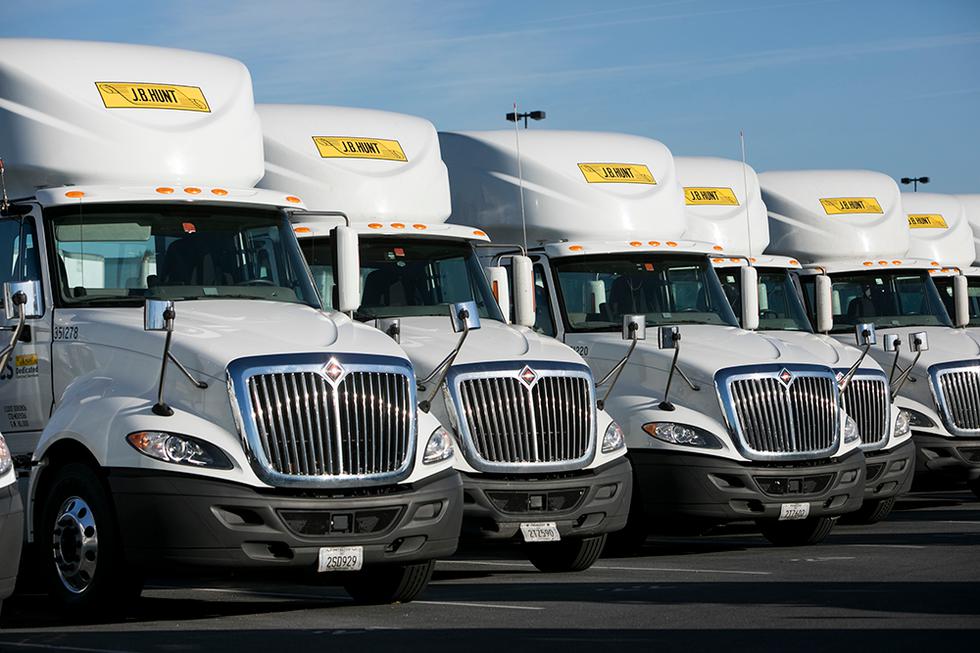
Kristoffer Tripplaar/Sipa USA via AP Images
Grassroots organizations have been pushing for attention to the rampant pollution caused by freight for decades.
In March, President Biden’s Environmental Protection Agency moved to regulate diesel pollution by regulating nitrogen oxide release from heavy-duty trucks, starting in 2027. This was, according to the EPA, the first step toward a zero-emissions freight sector. Now, Congress has allocated more than $4 billion toward this goal within the Inflation Reduction Act of 2022, the pared-down version of President Biden’s Build Back Better agenda. The bill, which also contains health care and tax measures, is by and large a climate bill—the largest ever—and meant to get the country to a 40 percent emissions reduction goal by 2030.
It’s part of what has been described as a $60 billion environmental justice commitment, aimed at reducing pollution in communities of color. This includes Superfund cleanup of toxic waste sites, grants to disadvantaged communities to reduce carbon emissions, greening of transportation hubs, electrification of public housing, and funding for better implementation of the National Environmental Policy Act, which seeks to protect low-income communities from harmful side effects of energy development.
The Inflation Reduction Act’s concessions for continued oil and gas production, while tempered somewhat by attempts to reduce methane leaks and capture carbon dioxide, have many climate justice groups condemning the effort as not worth the trade-off. But the cleaner ports funding represents one clear way to address an issue that is disproportionately affecting marginalized communities.
“While making the transition to [electric heavy-duty vehicles] won’t eliminate the problem of pollution entirely, they will tangibly improve the situation in many of our most impacted communities over the near term, a policy win however you look at it,” Marcos Ceniceros, executive director of Warehouse Workers for Justice, said over email.
The freight sector’s network of ports and its reliance on heavy-duty diesel trucks are massive sources of diesel pollution, a particularly noxious type of pollution made up of particulate matter. Grassroots organizations have been pushing for attention to the rampant pollution caused by freight for decades. As I previously wrote, the low-income people of color who live within areas dubbed “diesel death zones” are often the workers who keep the freight sector running.
The Inflation Reduction Act attempts to address these concerns by amending the Clean Air Act. By doing so, Democrats pressed further toward a zero-emissions freight sector by including funds to transition from and replace emission-emitting vehicles and equipment. However, the bill hardly acts as a sweeping solution to the crisis. The Moving Forward Network coalition has called for a zero-emissions freight sector, which the Inflation Reduction Act stops short of mandating.
The bill allocates $1 billion for clean heavy-duty vehicles. This money can be used to replace trucks and equipment with models that emit zero exhaust emissions, defined as any air pollutant or greenhouse gas. Purchasing, installing, training, and maintaining are all eligible uses of the money. School or mass-transit buses and garbage trucks qualify under this provision as well. Of this total, $400 million is specifically set aside for vehicles servicing communities that do not meet air quality standards, part of the Justice40 initiative to ensure that 40 percent of the benefits of large-scale public investments flow to marginalized or underserved communities. The overall $60 billion for environmental justice out of a $369 billion package does not reach this 40 percent goal, however.
These Neighborhood Access Equity Grants can be used to improve walkability, complete streets, as well as to provide “affordable access to essential destinations.”
Ports are intersections of many diesel polluters. There are massive amounts of diesel pollution that emanate from heavy-duty trucks and cargo ships, along with the everyday pollution cities naturally produce. Port cities are often disproportionately made up of people of color who have to deal with an abhorrently low quality of life, marked by high rates of asthma and cardiovascular disease among the population.
In the bill, $3 billion is designated for cleaner ports more generally, with a focus on how this money can be used to purchase and install zero-emissions port equipment. And as The Hill noted, “$750 million will go to ports in areas not attaining a national ambient air quality standard, which too often include low-income or disadvantaged communities.”
Also, $60 million is made available to “identify and reduce diesel emissions resulting from goods movement facilities,” a provision meant to specifically address the inequitable pollution in low-income and disadvantaged communities. Inequitable distribution of air pollution is further addressed by grants in a later section of the bill, where $3 million is made available to monitor air quality in low-income and disadvantaged communities through sensors, as well as maintain fenceline air monitoring.
Further, there is $3 billion allocated to “reconnect communities divided by existing infrastructure barriers,” as well as reduce the harm caused by transportation facilities or construction projects in low-income communities. These Neighborhood Access and Equity Grants can be used to improve walkability, complete streets, as well as to provide “affordable access to essential destinations.” It’s an extension of the $1 billion Reconnecting Communities grants from the bipartisan infrastructure law, though that money was specifically about restoring neighborhoods of color cut off from one another by highways and other infrastructure barriers.
The Inflation Reduction Act is rightfully being lauded as a massive piece of climate legislation. Activists will surely note the shortfalls of the bill, given that it does not mandate zero emissions and that it requires more oil and gas leasing in federal lands and waters. The environmental justice–related efforts essentially put money on the table, placing the onus to take it on local and grassroots movements.



